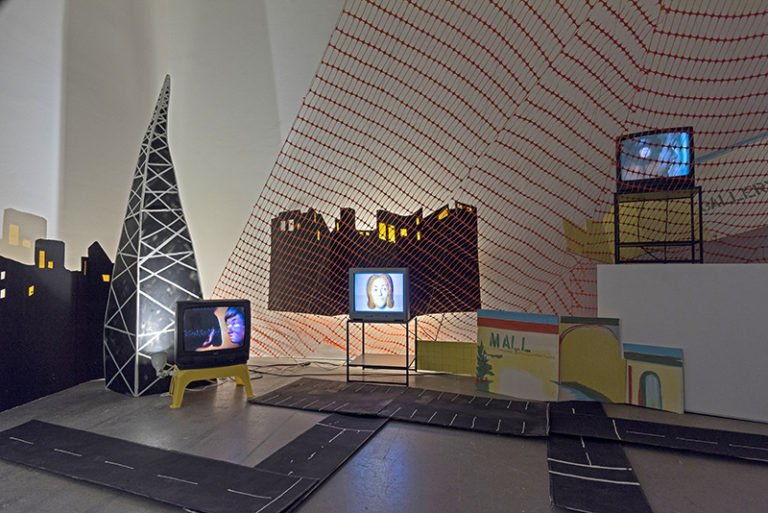“Introducing Tony Conrad: A Retrospective” is the first large-scale museum survey devoted to work originally presented by the artist in his museum and gallery exhibitions. It premiered at the Albright-Knox Art Gallery and has traveled to the Institute of Contemporary Art at the University of Pennsylvania where it is on view through August 11. It is a terrific send off for an under-recognized artist.
Conrad, who died in 2016 at the age of 76, is one of those uncommonly delightful figures of the second half of the 20th century who privileged disruption over mastery. His instinct was to eschew the pressures to adhere to a specificity of discipline and really lean into interdisciplinary crossovers that now seem ubiquitous. He opened creative possibilities between art and film, film and music, music and performance in contemporary practice that were quickly picked up and acted upon by other artists. He often was the one who got there first. Innovators are not always the ones who reap the rewards, nor do they necessarily want to. Perhaps this is why Conrad is not well known and this exhibition is a revelation.
Anti-gallerist and anti-commerce for much of his career, he taught for a living at the University of Buffalo. He made art that would not, or he would not, sell. An artist’s artist, some knew of him, were influenced and worked with him, like Mike Kelley, Tony Oursler, Cory Arcangel and Constance DeJong. Yet even Conrad said of himself, “You don’t know who I am, but somehow, indirectly, you’ve been affected by things I did. I don’t mind being anonymous though.”
As a young man Conrad was already immersed in art and avant-garde music while he studied mathematics at Harvard University. By 1962 he began playing violin with the Theatre of Eternal Music, a pioneering drone-based minimalism project with John Cale, La Monte Young, Marian Zazeela, Angus MacLise and others. For a brief moment he was part of The Primitives, a proto-Velvet Underground band with Lou Reed, Cale, and Walter De Maria. Conrad was also roommates with the pioneer filmmaker and performance artist Jack Smith, and made music for some of Smith’s films.
When he was given film stock from Jonas Mekas, Director of the Anthology Film Archives, Conrad began making groundbreaking films of his own. The first major work that stands out from this propitious moment is The Flicker (1966), an underground work, which literally flickers like a strobe light. It is about the very act of projection itself. The movie is accompanied by a warning that it may cause seizures, and numerous persons have left screenings with headaches and feeling ill.

Tony Conrad, Retrospective, installation view (2019) courtesy The Institute of Contemporary Art at the University of Pennsylvania.
The exhibition covers an enormous amount of ground and numerous works stand out that evidence Conrad’s restless spirit and sensibility of consistently challenging systems and boundaries. In particular his Yellow Movies (1972-73) are unique, seemingly endless durational works that employ no film or projectors. Elsewhere there are drone instruments he invented that investigate the confluence of harmonics, music and sound. Then in 2016, as perhaps an unintentional parting gesture from someone who seemed to impart a degree of humor in everything he did, there is a hilarious installation of oversized underwear entitled Undone. It bemoans aging and the ridiculous indignity of it all as the body sags and loses its functionality.
Some of his video projects, like the Homework Helpline on Buffalo Learning Television from 1993–97, are especially affecting and unexpected because of their earnestness and kindness. Conrad is just great with kids.
Several movies featured Kelley and Oursler. They were Hail the Fallen (1981) and Beholden to Victory (1983), both war movies, and a B movie genre “women- in- prison” film, Jail Jail (1982–83). In these you see the young artists performing in what seem to be improvisational styles, seemingly without direction. Jail Jail’s set is recreated in the exhibition. It was scheduled to be continued 30 years after its initial shoot, by bringing the actors back, but was cancelled after Mike Kelley’s death.
If Conrad was a free spirit and a restless mind, then he was also The Joker in the midst of an art world that became unrecognizable and market-driven with a cruel speed that almost left him behind. This wonderful exhibition more than makes up for it, and it is a shame he isn’t here to upend it somehow, because given his nature I am guessing that is what he may have planned to do.



















0 Comments